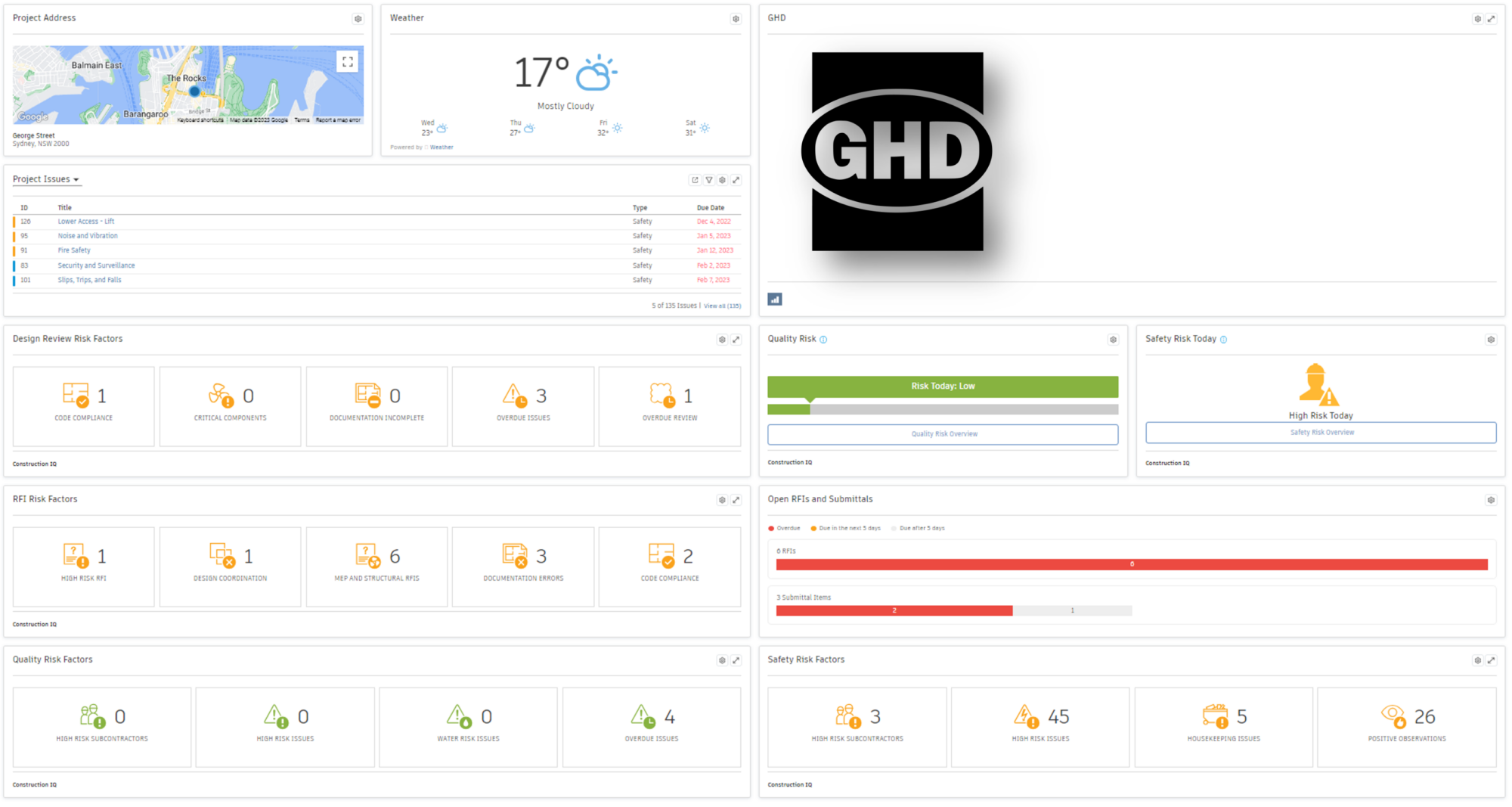
If you work in construction, you know how easy it is to fall into analysis paralysis. There's so much data being produced that sifting through it to find actionable insights can be a massive lift.
Not to mention, making the wrong call due to bad data is extremely costly. Construction Dive reports that in 2020, bad project data cost contractors worldwide over $1.8 trillion. Additionally, 14% of all rework in construction globally was caused by inaccurate or insufficient data.
The pressure to maximize your use of data doesn't stop with having accurate information. You must also leverage that data to develop smart priorities and decisions, which can be tricky given that construction teams often deal with multiple complex projects.
Which issues should you work on first? What is the best use of your and your team's time? How do you minimize risk and keep the jobsite safe?
Leveraging project data isn't just about having the correct info; it's also about obtaining knowledge to aid decision-making.
In other words, it's about making data useful.
This is why tools like Construction IQ are so valuable. Construction IQ helps you identify and prioritize project risk through built-in machine learning and AI functionality.
In this article, we look back at the AU session, Maximizing Construction IQ and Machine Learning for Predictive Analytics, where we explored the notable features of the construction management software. I was joined by Steven Bloomer, Regional BIM Lead at GHD, who shared real-life examples of Construction IQ in action.
Want to learn more about KPIs, dashboards, and benchmarks in construction? Join our webinar, Actionable Analytics Reports & Top Construction KPIs to Measure.
Let's explore the key takeaways from the session.
While many companies boast about their AI capabilities, Autodesk sets itself apart as a true pioneer in the field. In fact, Construction IQ is the first construction platform to provide AI-powered insights and has been used more than 5 million times in the last year.
Here's why construction teams get so much value out of Construction IQ.
Trained on high-quality data sets + reviewed by SMEs
The AI and machine learning technologies that power Construction IQ have been trained on years of data from leading construction firms. They are also trained using independent and nested AI models to provide accurate predictions to users.
In addition, Construction IQ is trained by subject matter experts, specifically focused on using Autodesk datasets and approved data provided by customers.
Beyond that, SMEs review the outputs to ensure we have the correct information. If we disagree with the tool's output, we can update it and further train the programs.
Designed to provide you with personalized insights
Another thing that makes Construction IQ unique is its ability to adapt and tailor its insights specifically to the needs of your project teams.
Steven explained, "Construction IQ leads with information your team puts into Issues, RFIs, and Forms. Then, Autodesk Construction Cloud's advanced analytical platform—using artificial intelligence and machine learning—provides quick insights into your construction projects, performance risk management, and decision-making."
"It acts as a digital brain constantly analyzing vast amounts of data. Your team is provided with predictive insights that will not be possible with the likes of traditional dashboarding."
We touched on the notable capabilities of Construction IQ, but what exactly does it look like in action?
Let's explore a couple of real-life examples from teams using the solution.
Reducing safety risk
It's no secret that safety risks are higher at construction sites. According to Steven, "Research has shown that fall from heights struck by objects, electrocution, and caught in or between machines, rotating equipment, or collapsing structures leads to the majority of all fatalities on a construction site. Sometimes, these are referred to as the Fatal Four."
The best way to ensure that the Fatal Four doesn't appear at your job sites is to mitigate them during the Safety in Design activities. Steven said that at GHD, they use Construction IQ in the Safety in Design process by leveraging the model to assist in the process.
"Model Coordination will first federate all discipline models into one single view. We typically use this in parallel with Design Collaboration to ensure that only models suitable for sharing between the design teams are federated and used in the review process," he added.
From there, they navigate the site and create project issues within Autodesk Construction Cloud when safety risks are identified. When you finish logging an Issue, you can include a description and identify the root cause.
The next step is where the magic happens, said Steven.
"Construction IQ will review your Issues, the descriptions you have entered, and the due dates captured. Within the Insights panel, high-risk safety issues will be grouped to assist you and your team in quickly resolving these issues."
"Through AI, Construction IQ has identified the risks and hazards within each Issue description you have entered to do the thinking for you."
This is a game-changer when you need to prioritize a host of issues.
"Imagine you're on a project with 100+ safety issues identified," said Steven. "Where do you start to provide mitigations or potential control measures? If it was me, and before I started using Construction IQ, I'd start at issue one and work my way through the list. This is not the most effective solution. Construction IQ allows you to review issues in order of priority to make your life easier and ultimately reduce the risk to your projects."
Site inspections

GHD also uses Construction IQ to streamline site inspections.
"In the past, we would travel to a site with a clipboard and complete either a paper form or checklist. Photos will be taken, and when back in the office, photos will be linked, and a report will be submitted to our clients," recalled Steven.
Now, they use Autodesk Construction Cloud's mobile app for everything from checklists and reports to inspections and site walkthroughs. With the help of Construction IQ, GHD's teams can prioritize issues based on risk, enabling a targeted approach to tackle high-priority items first.
"Within the insights tool and utilizing Construction IQ cards, quality issues are grouped based on risk factors. This will allow the design, contractor, and subcontractor teams to take action on high-priority items first, focusing resources on what matters and returning to the other issues later. Through the use of Construction IQ and leveraging the AI capabilities, project teams have a more focused approach to issue resolution," explained Steven.
You've seen what Construction IQ can do. Now, let's talk about how you can get started properly and get the most out of the software.
Set up the right project types
Make sure you set up your project types correctly. Construction IQ's machine learning algorithms are optimized only for Commercial, Residential, Healthcare, and Institutional projects. So, when setting up your projects, see they are set up to one of these types. If not, you can always go into your project admin settings and edit this project type.
All you need to do is go to the settings page, click edit, and select the appropriate type from the dropdown.
This is a crucial step because unless you set up these projects as one of the project types above, the Construction IQ and machine learning analytics will not be displayed.
Use the Insight interface
You can also access Construction IQ-powered cards. Simply navigate to the Insight module and select the specific area you want to explore. Currently, you can choose Risk, Design, Quality, or Safety.
If you choose Risk, for example, you can see various Construction IQ cards that display AI- and ML-powered info, such as which Issues are high-risk, overdue, etc. If you navigate to the Quality section, you'll see quality risk factors at the forefront, allowing you to prioritize and address these concerns efficiently.
Leverage actionable insights
As I mentioned earlier, analysis paralysis is a real pain point in construction because there's so much information available.
Enter Construction IQ, which makes all that data actionable.
Let's go back to the Fatal Four example. Construction IQ identifies these risks and other safety concerns under the safety category. This lets teams directly click on high-risk factors and issues for a detailed view, enabling immediate action.
Create custom dashboards
Next up, you can create custom dashboards. This feature is incredibly handy, especially for complex projects that involve large teams. Custom dashboards give all project stakeholders a consistent view of Issues and RFIs.
You can start creating custom dashboards from the Insight page. Click the create a dashboard button, assign a name to your dashboard (e.g., "hospital"), and then use the Card Library to add the cards you need.
You can select and drag Construction IQ cards and other relevant cards like Safety, Risk, Quality, etc., to your dashboard. Position these cards according to your preferences to customize your view.
When you're happy with your dashboard, hit save, and it will be listed on your Insight module.
Share your dashboard with stakeholders
Teams can't act on data and insights if they cannot access the necessary information. That's why we've made it simple to share custom dashboards with internal and extended team members.
You can export the dashboard and share it with a company, role, or user—including external stakeholders. You can also manage permissions by choosing whether or not a dashboard can be accessed by all project members, select project members, or just you.
If you choose to share it with others, they will get a notification and the dashboard will be added to their Insight module with just a few clicks.
Risk mitigation will continue to be a top concern for construction firms globally, which makes tools like Construction IQ more vital than ever. By harnessing the power of AI and machine learning, teams can mitigate risks and enhance efficiency, safety, and decision-making across projects.
If you want to get more out of your data and fully maximize the potential of AI, check out Construction IQ and learn why leading companies consider it their go-to solution for predictive analytics, risk management, and project insights.
